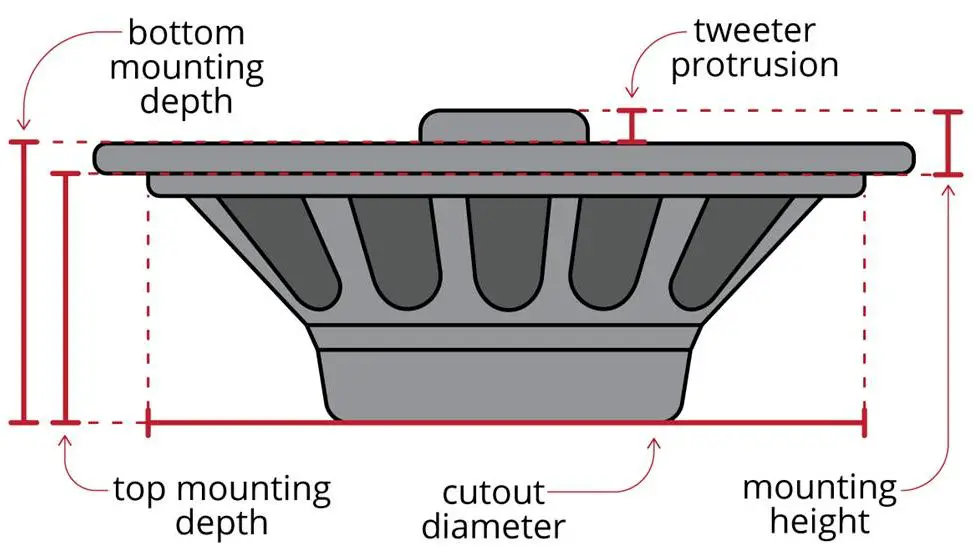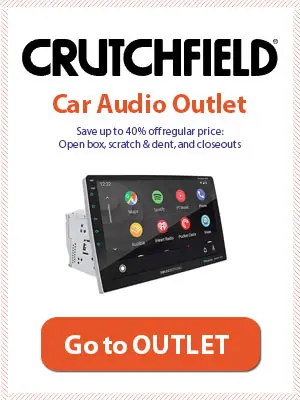Before you start the process of upgrading your vehicle’s audio, you will need to make sure that you’ve got everything figured out about your existing setup. In simple words, you must know “what size speakers are in your car?”
Otherwise, you might end up with new car speakers that don’t even fit your car. So before you start your shopping for new speakers for your ride, you must determine the size of your existing speakers. Here’s how you can do that.
Table of Contents
How to Measure Car Speakers? (STEPS)

Step 1: Get the Right Tools
The things you will need to measure the size of your car speakers include a tape measure, screwdriver, panel removing tools, notepad, and a pen. Grab these tools and get on to measuring the size of the speakers.
Step 2: Remove the Panel
If your car speaker is located on the door panel, remove the panel from the door to expose it. You might not have to remove any panel for the front and rear speakers.
Step 3: Remove the Speaker
Use the screwdriver to loosen the screws and remove the speaker. Place it on a solid, flat surface where you can easily take the measurements.
Step 4: Measure the Mounting Depth of the Speaker
Place one end of the tape measure just below the mounting plane and the other at the end of the magnet and note the length down on a notepad. This will ensure that the new speaker isn’t too deep to touch any surface beneath it during installation. If you don’t get the length right, the new speaker wouldn’t install properly since the screws would not tighten.
Step 5: Measure the Height of the Speaker
Measure the height of the speaker starting from the bottom of the mounting plane all the way up to the highest point. If you don’t measure the height properly, your new car speaker might stick out.
Step 6: Measure the Diameter of the Speaker
This step is extremely important because speakers, as you already know, are distinguished by their sizes. A speaker with a 6” diameter has this measurement in its product name. Once you have measured the size of your speaker, you will find it easier to select a similar one.
To measure the diameter of your speaker, place one end of the tape measure at the end of the car speaker and the other at the far end. Keep the tape close to the center. Correct measurement will ensure that your new speakers fit the mounting depression.
Step 7: Measure the Distance between Screw Holes
Taking screw holes measurement will save you from the trouble of drilling new holes because the new speaker will easily fit into the existing holes. However, this step isn’t necessary if you plan on using different kinds of screws.
Video Tutorial
Online Tools May Save You Some Time
You don’t always have to measure the size of your factory car speaker when you are looking to upgrade your existing setup. Crutchfield’s online tool called the “OutfitMyCar tool” can help you determine which aftermarket speakers will fit your vehicle. Every aspect of a speaker has been measured for this tool to provide users with a selection of speakers that will fit their ride.
Why You Shouldn’t Rely Soly on the Manual?
The size measurements that are indicated on the car speaker itself are related to hole alignment and the frame’s diagonal measurement. Therefore, the measurements aren’t only about the cone’s diameter or of the speaker’s cutout diameter. The actual size of a speaker depends on the manufacturer’s design. For instance, Pioneer TS-Z65F 6.5″ speakers may not be equal to the Infinity Kappa 62IX 6.5″ speakers even though both are 6.5-inch speakers. The measurements might be close to 6.5” but not exactly 6.5”. This is why you can’t just rely on the manual when choosing a new speaker for your ride.
Trial and error
Finally, you could always try the good old fashioned trial and error method. This is where you try out several different sizes on the car until you find what fits best. This method is obviously very tiresome but can prove advantageous by exposing you to amazing new speaker sizes and combinations that have not been tried before but actually work.
Exploring Your Options
You have measured the speakers installed in your car, now it is time to choose from the variety of speakers available in the market. Here are some options for you to consider.
6”x9” Speakers
6”x9” speakers are pretty powerful and they are suitable for a number of vehicles – see our recommendation of the best 6×9 speakers. Since they have a wider cone around them, they should be able to produce some bass, possibly eliminating the need to install woofers and subwoofers. In the majority of vehicles, 6”x9” speakers are found at the back of the vehicle, but they can also be installed all the way around.
6.5” Speakers
6.5” speakers are the most popular choice among car owners looking to upgrade their existing setup. Since they are extremely common, they are available with a number of upgrades – full review of best 6.5 car speakers. The phrase jack of all trades, master of none fits these speakers perfectly since they aren’t particularly good at one thing. They aren’t too bad but don’t expect great clarity or incredible bass from them.
4”x6” Speakers
Although these car speakers lack when it comes to bass, they do allow for a wide range of sounds. They are used in a number of vehicles, but they aren’t as common as the 6”x9” speakers. There are lots of different upgrades available for these speakers – check some of the best 4×6 speakers we recommend. So if you are looking to replace your existing 4×6 speakers, you should be able to find plenty of options in the market.
Tweeters
These tiny totters fall within the 1” to 2” speaker size range – check some of the best car audio tweeters. They are amazing support sound speakers that perfectly complement car audio systems without stealing the show.
Conclusion
We have shown you exactly how you can measure the speakers installed in your car. Follow the steps we have discussed above to determine the size of your existing car speakers. This way you will be able to buy new speakers of the right size for your vehicle. We have also discussed some common speaker sizes to make it easier for you to find the speakers that will fit your car.
Last update on 2024-04-26 / Affiliate links / *Image Disclaimer: We use images/data from Amazon Product Advertising API solely on products that link to Amazon. On products with the "Price at Crutchfield" button, we use images/data from Crutchfield.com as per the partnership deal.
